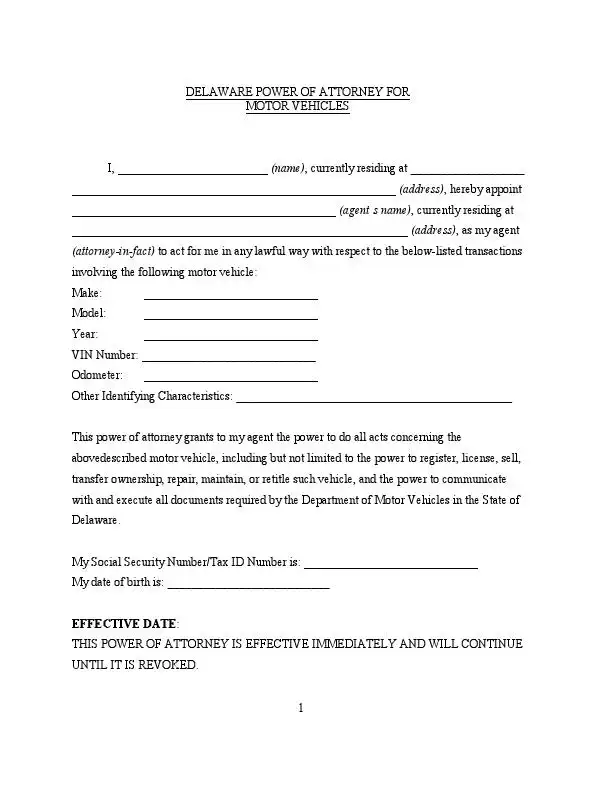Delaware Motor Vehicle Power of Attorney Form
The Delaware motor vehicle power of attorney (Form MV-386) allows an individual (the principal) to grant another person (the agent) the authority to handle vehicle-related matters on their behalf. The power of attorney template allows a vehicle owner (the principal) to authorize another person (the agent) to perform various transactions related to the vehicle on their behalf.

Build Your Document
Answer a few simple questions to make your document in minutes
Save and Print
Save progress and finish on any device, download and print anytime
Sign and Use
Your valid, lawyer-approved document is ready
These transactions can include:
- Transferring the vehicle title.
- Registering the vehicle with the Delaware Division of Motor Vehicles (DMV).
- Completing the sale of the vehicle.
- Managing liens on the vehicle.
Using Form MV-386 can be especially helpful for individuals who cannot personally handle their vehicle-related matters for various reasons, such as being out of state or incapacitated.
Under the Delaware Code, the power of attorney form must comply with specific legal requirements for validity. The principal must sign the form in the presence of a notary public. This notarization process confirms the principal’s identity and willingness to grant the specified powers to the agent. Here are all the steps to properly execute a Delaware motor vehicle POA:
- Complete the form. Fill out all required sections, including the principal’s and agent’s details, and specify the powers granted.
- Sign the form. The principal must sign the document in front of a notary public.
- Notarization. The notary public will verify the principal’s identity, witness the signature, and affix their notarial seal.
Failure to follow these steps may result in the POA being deemed invalid, complicating the execution of vehicle-related transactions. The principal and agent should also retain copies of the completed and notarized Delaware POA forms for their records.
Delaware Motor Vehicle Power of Attorney Form Details
| Document Name | Delaware Motor Vehicle Power of Attorney Form |
| State Form Name | Form MV-386 |
| Relevant Link | Delaware Division of Motor Vehicles |
| Avg. Time to Fill Out | 10-15 minutes |
| # of Fillable Fields | 21 |
| Available Formats | Adobe PDF |
Filling Out Delaware Vehicle POA
When completing the Delaware motor vehicle POA form MV-386, you must follow each step carefully to ensure the document is executed correctly. Below are detailed instructions on how to fill out this document.
1. Enter Your Information
Enter your full name as the principal (the person granting the power). Below your name, provide your complete address, including city, county, and state. This information establishes your identity and residence for the legal document.
2. Designate Your Attorney-in-Fact
In the space provided, write the full name of the person you appoint as your attorney-in-fact (the agent who will act on your behalf). This individual will have the authority to sign documents related to the transfer of your vehicle. Following the name, enter the complete address of your attorney-in-fact, including their city, county, and state.
3. Describe the Vehicle
Detail the vehicle involved by entering its make, model year, and Vehicle Identification Number (VIN). This information must be accurate to ensure the correct vehicle is covered under the POA.
4. Sign and Date the Form
As the principal, you must sign the form to validate it. Place your signature in the designated area along with the date. This shows your consent to the powers granted in the document.
5. Include Co-owners Signature (If Applicable)
If the vehicle is co-owned, the co-owner must also sign the form. This part of the form ensures both owners agree to grant the attorney-in-fact the power to handle the vehicle’s title transfer.
6. Notarization
The form must be notarized to confirm its authenticity. Take the document to a notary public. You (and the co-owner, if applicable) should sign the form in the notary’s presence. The notary will fill in the county, date, and seal, completing the process.
